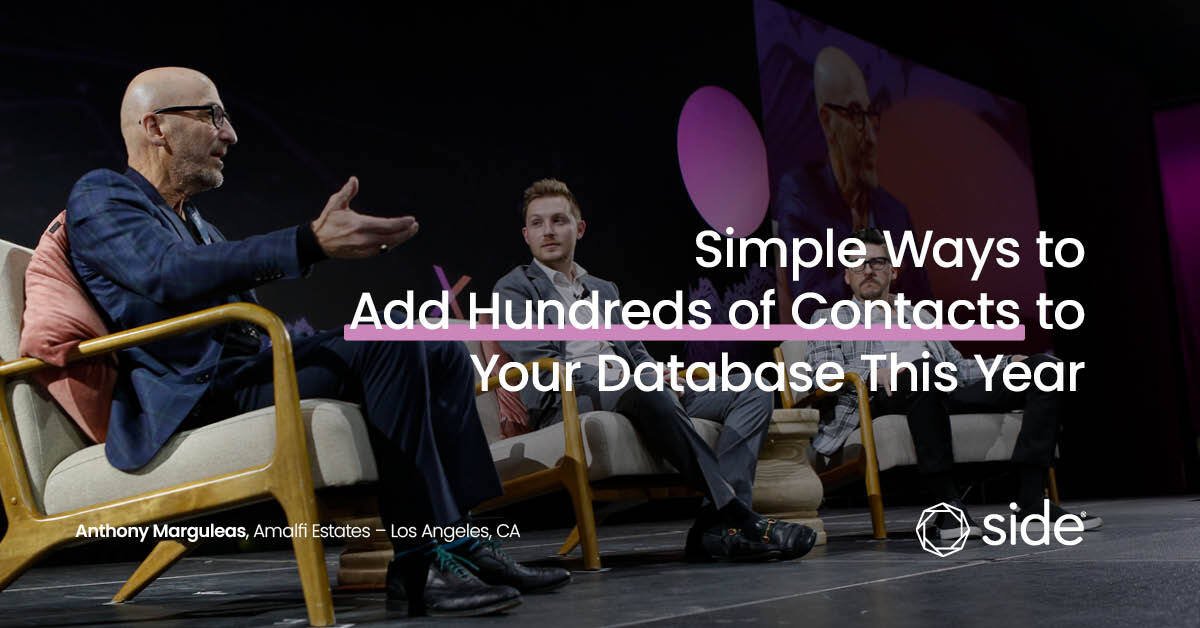
Anthony Marguleas, founder of Amalfi Estates, has a simple formula to keep his pipeline full: Add four new email addresses to his database every day.
Hit that target and one year later, you’ll have over 1,400 new contacts in your database. In five years, you’ll have over 7,000.
Best of all: If you keep to traditional real estate prospecting methods (and avoid buying leads), you won’t have to pay a referral fee if any of those leads convert.
To hit that four-emails-a-day target, Anthony recommends spending at least two hours a day prospecting, either through door knocking or circle dialing. Here’s exactly how he and two members of his team, Chad Singer and Brian Bogulski, use both strategies to fill their pipelines.
Door Knocking Strategies:
1. Set realistic goals
Door knocking is not a one-and-done activity — it takes consistent effort to build up an income-generating client list. And one of the best ways to achieve that consistency is to set yourself up for success by not aiming too high.
“If I tell myself I’m going to knock on 500 doors today, I’m probably not going to hit that goal,” said Chad Singer. “If I tell myself I’m going to knock on 10 doors, I probably will hit that. And if I do that consistently, I’ll be hitting hundreds a month.”
The agents at Amalfi Estates each have a goal of knocking on 120 doors each month, which breaks down to 30 doors a week. The idea isn’t to hit all 120 in one marathon spring, but to weave door knocking into your schedule on a regular basis.
If I tell myself I’m going to knock on 500 doors today, I’m probably not going to hit that goal. If I tell myself I’m going to knock on 10 doors, I probably will hit that.
— Chad Singer, Amalfi Estates
2. Deliver as much value as possible
Too many agents make door knocking all about them, showing off their recent sales or immediately pitching their services. But the goal isn’t to make a sale on the spot, it’s to add prospects to your database so you can gradually build a relationship with them.
The best way to do that is to provide value right out of the gate.
“We know our market very well, and we share that knowledge with people we meet when door knocking,” said Chad. “If I’m sharing information about something that might be helpful or impact them down the road, that builds a connection.”
Some examples of value-add topics of conversation include:
- Inviting the neighbors of an upcoming listing to a private open house before it goes on the market
- Sharing information about upcoming tax laws that may impact them as homeowners
- Offering tips and vendor recommendations for spring cleaning
- Advice on how and why to put your property into a living trust
- Vary your materials each time, and you’ll be able to hit the same doors on a monthly basis.
3. Be mindful of your timing
Make sure you’re out door knocking at a time when most people will actually be home.
“Three to five p.m. is probably the best window for face-to-face interaction,” said Chad. And actually having a chance to connect with the prospect in person makes all the difference.
“Let’s face it: If you’re just leaving your business card and they’re not home, it’s going in the trash.”
4. Bring a partner
When door knocking, two is better than one.
“Ideally, go with someone different than you,” said Chad. Try door knocking with someone of a different gender or background than you. The goal is to connect with people, and having someone who compliments you can make the people answering the door feel a bit more comfortable.”
Don’t let anyone tell you you can’t door knock in expensive neighborhoods.
— Anthony Marguleas, Amalfi Estates
5. Don’t ignore expensive neighborhoods
It’s a myth that door-knocking only works below a certain price point. If you approach it with consistency and always add value, you can see success in any market.
“Ben Affleck’s home in Pacific Palisades was door knocked, and they got the listing,” said Anthony. “That’s a $20 million listing from door knocking. Don’t let anyone tell you you can’t door knock in expensive neighborhoods.”
Circle Dialing Strategies:
1. Save time with automation
Circle dialing involves picking up the phone and calling people who live in a certain radius of a property that’s sold in the neighborhood — which can be time-consuming.
But with the right tools, you can make more calls in far less time.
The team at Amalfi Estates uses Mojo Dialer to facilitate circle dialing. You input the list of people you want to call, and Mojo Dialer auto-calls three people at once. If no one answers, it leaves a pre-recorded voicemail. If more than one person answers, the dialer will put you on with one prospect and the other will get a recording that makes it sound as though you’re having trouble hearing them because of a bad connection. This gives you a chance to finish up with prospect one and then give a call back to prospect two.
“With the triple dialer, I can make up to 120 calls in one hour,” said Brian Bogulski. “And I’m not even touching any buttons, it’s automatically dialing these numbers for me.”
2. Take advantage of upcoming listings
With circle dialing, as with door knocking, you want to lead with value. And one of the most valuable insights you can give a prospect on the phone is details about a listing coming to market in their neighborhood.
“I recently had a listing where there was some lead time before it came to market because the seller was doing renovations,” said Brian. “So about a month or two before it came to market, we circle dialed all the neighbors to invite them to a neighbor-only preview of the house. I asked for their email address so I could send them the invitation. From that one campaign, I captured 70 emails.”
3. Follow up via your CRM
If you speak to a prospect willing to share their email address, add it to your CRM asap.
“I can press a button in Mojo Dialer that automatically puts that contact into my CRM, Follow Up Boss, along with my notes,” said Brian. “All I have to do is press a button.”
Once their email is in your CRM, you can add your new contact to relevant email campaigns to keep them engaged.
You can’t improve if you’re not measuring something.
— Brian Bogulski, Amalfi Estates
4. Track your progress
Brian recommends recording your calls and playing them back later to learn from your mistakes. “You can’t improve if you’re not measuring something,” he said.
Having access to the recording lets you track how closely you stick to your script and identify which objections you tend to have trouble with so you can work on them.
And if you’re worried about the time commitment associated with listening to all your old phone calls, there’s a way around that.
“We actually have a virtual assistant who listens to the calls we record,” said Anthony. “The assistant then grades each based on a grading system we created so each agent knows where they need to improve.”
5. Make it fun
Real estate prospecting can be tedious, but it gets results. If you find your team is struggling to put in the work, try reframing it as a game.
“We have competitions going in our office,” said Anthony. “If you make 500 circle prospecting calls a week, I’ll pay the full cost. And if you knock on the most number of doors in a given week, you’ll win a $100 gift card to your favorite restaurant or coffee shop.”
Do whatever you can to keep yourself and your team motivated to keep plugging away. Remember: Prospecting is a long game. In a few years, when your database is a few thousand contacts deeper and several of those contacts are ready to move, you’ll be grateful you put in the time.
